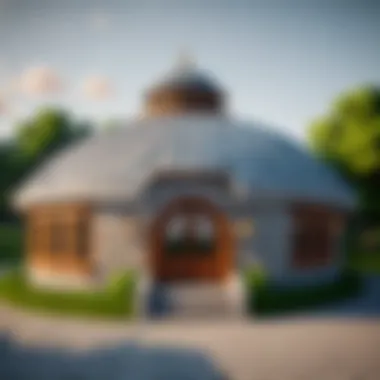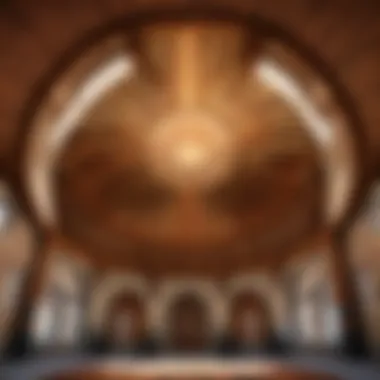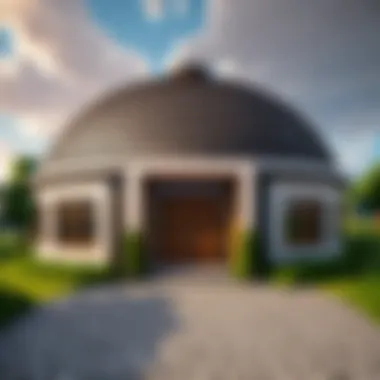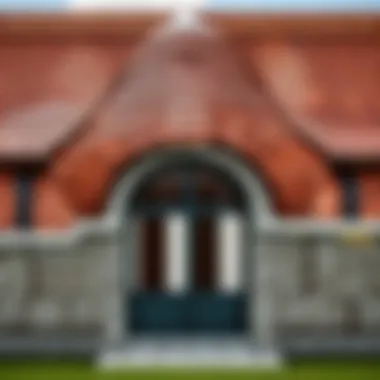The Round Roof: Architecture's Intriguing Design Element


Intro
Round roofs, characterized by their sinuous forms and elegant silhouettes, serve not merely to cap structures but to evoke a specific architectural ethos blending functionality with aesthetic grandeur. This exploration aims to clarify these popular roofs’ relevance within modern and historical contexts. Through careful dissection of their design principles, material utilization, and diverse applications, readers will appreciate the nuanced beauty and structural significance that round roofs contribute to architectural endeavors.
The value of round roofs goes beyond mere appearance. They have historical roots that trace back to various cultures, often adopted to adapt to specific environments and climate conditions. Their performance can influence energy efficiency and structural integrity, inviting architects to experiment with innovative designs.
Examining contemporary applications reveals intriguing trends among eco-conscious designs and smart building technology, inviting a discussion about the sustainable features that aid performance and increase market adaptability.
Ultimately, this exploration resonates with both enthusiasts and professionals, aiming to elucidate the multifaceted world of round roofs in architecture. As we proceed through this article, we delve into each aspect in detail, joining a conversation on technique, function, and inception in architectural frameworks.
Prolusion to Round Roofs
Round roofs hold a significant position in architectural design, serving both practical and aesthetic purposes. They contribute to the structural integrity of buildings while also providing a unique visual appeal. Understanding round roofs is crucial, as they offer advantages like improved energy efficiency and natural ventilation.
Definition and Characteristics
Round roofs can be defined predominantly by their curved shape, distinguishing them from conventional flat or sloped roofs. These designs can increase the interior space and enhance the airflow within structures. Significant characteristics include:
- Shape: Typically dome-like, arched, or vaulted;
- Materials: Often constructed with diverse materials such as wood, metal, or concrete;
- Functionality: Designed to efficiently distribute weight and resist environmental stressors like snow or wind.
Such characteristics make round roofs applicable across many fields, ensuring their relevance across multiple architectural styles.
Historical Context and Evolution
Historically, round roofs date back to ancient times. The need for an efficient building envelope led to using circular forms, observable in great monuments and cultural artifacts worldwide. Early examples include the Roman Pantheon, showcasing advanced engineering practices where the rounded roof can disperse structural load effectively.
Over centuries, the evolution of round roofs reflects changes in architectural styles and technologies.
- Early Structures: Places like the Colosseum utilized round forms to shape large spaces where people gathered.
- Middle Ages: The introduction of Gothic arch techniques redefined the possibilities for using rounded designs.
- Modern Era: Today's architects embrace round roofs for sustainability and innovation in design.
Through this historical lens, it is clear that round roofs not only serve structural purposes but also encapsulate cultural significance, demonstrating architectural capability and style transformation.
Design Principles of Round Roofs
The phrase design principles in context of round roofs encompasses multiple aspects, like structural integrity, aesthetic appeal, and the selection of appropriate materials. Understanding these principles empowers architects and designers to create functional and visually appealing structures that can withstand various environmental stressors.
Structural Integrity
A round roof must have excellent structural integrity to ensure it remains safe over time. The shape itself provides inherent strength. Curved surfaces distribute weight evenly and reduce the risk of localized stress points. Ensuring this design holds strength under different loads is a priority. Engineers focus on load-bearing capability while using materials that support the form.
For example, cross-sectional analysis is crucial during the design phase. Different loads, such as wind and snow, must be calculated. An enclosed structure, like a geodesic dome, boasts superior performance resilience under varying conditions. However, designers must also acknowledge potential weaknesses in lesser-known designs.
Key factors in maintaining structural integrity include:
- Utilizing strong materials like reinforced concrete.
- Assessing the local climate for load implications.
- Defining clear boundaries in construction regulations.
Aesthetic Considerations
The aesthetic potential of round roofs is significant. Their unique forms can enhance visual interest in various architectural settings. Designers often explore combinations of curves and angles for unique expressions. Each round roof communicates a sense of unity and harmony, which is distinct from conventional building shapes.
Architectural appeal is achieved through various techniques. Use of color, texture, and lighting can influence how round roofs appear in the visual landscape. For instance, a wooden cupola atop a contemporary building makes a striking statement in urban surroundings, suggesting tradition juxtaposed with modernity.
Aspects to focus on in terms of aesthetics:
- Harmonizing the roof with surrounding elements.
- Choosing materials that provide texture and color.
- Considering the roof from both ground and unavoidable aerial perspectives.
Materials Commonly Used


The choice of materials significantly affects manufacturing and functional performance of round roofs. Various types are globally recognized for their durability and versatility.
Common materials include:
- Wood: Often utilized for aesthetic value and thermal properties.
- Steel: Provides robust support for larger spans, showing high longevity.
- Concrete: Popular for its capacity to mold into various designs and ease of insulation application.
- Glass: Found in skylights and atriums, enhances natural light flow while invoking modern design aspects.
Ultimately, selecting the right balances between appearance and endurance is vital. Material choice offers various advantages and meets specific climate challenges. Ultimately, it’s an integral part of the architectural round roof discourse that connects function to beauty.
Understanding the design principles of round roofs helps in bridging the gap between function and form, thereby enabling architects to create remarkable structures with desired performances.
Types of Round Roofs
Round roofs have distinct applications and aesthetic considerations in architecture. Understanding the different types of round roofs is essential for appreciating their diverse functionality and design. Each type offers unique attributes influencing structural integrity, visual appeal, and utility in various settings. As we explore the specific types, we will uncover the benefits and considerations related to each form. This will enrich anyone's architecture perspective, crucial for architects and enthusiasts alike.
Geodesic Domes
Geodesic domes, a hallmark of modern architecture, have gained attention for their efficiency and design. These structures are formed by a network of triangular elements that distribute stress evenly across the surface. The combination of lightweight materials and geometric precision contributes to superior stability.
One key advantage of geodesic domes is their energy efficiency. By minimizing material waste and maximizing interior space, they create an optimal environment conducive to natural ventilation. Moreover, their curved shape presents an appealing visual to onlookers, often signifying innovation. As such, using a geodesic dome may enhance a building's profile while providing functional design solutions.
In residential structures, for example, the aesthetic of a geodesic dome allows for unique living spaces, combining functionality and modern styling wonders. In commercial settings, they can improve public engagement, drawing attention due to their striking form and space usage.
Barrel Vaults
Barrel vaults showcase an ancient architectural technique that provides a long, continuous arch. This structure is created by extending a simple curve along a length, which leads to vast expanses of interior space. The strength of these vaults allows them to be employed in various settings from historical cathedrals to contemporary shopping centers.
Considerations for using barrel vaults are predominantly around acoustics and light control. The shape promotes sound flow and can lead to stunning effects when combined cleverly with lighting design. The grandness of a barrel vault often conveys a sense of permanence or transition, making it a popular choice for significant installations. Architects aiming to convey spirituality or grandeur often resort to this architectural type.
Because barrel vaults can consume substantial materials, planning for correct ratios and balances is essential to maintain associated costs. In comparison to other roof types, the scalability of barrel vaults significantly benefits larger projects, both residential and commercial.
Cupolas
Cupolas, smaller in form yet grand in impact, serve as canopies crowning a building. Their circular design enhances airflow and light diffusion while offering a decorative focal point. Very often seen on top of farms, barns, or colonial-style houses, cupolas embody traditional charm combined with a practical approach to ventilation.
A major advantage of cupolas remains their versatility. They can effortlessly fit various architectural styles without feeling out of place. In residential settings, a well-placed cupola can elevate the home aesthetic while adding beneficial vents for circulation.
However, careful analysis during the planning phase is critical for determining the ideal placement and size. An inappropriately sized cupola may result in functionality loss and aesthetic imbalance. It’s advisable to blend cupolas with the broader surrounding architecture. By doing so, designers maintain a coherent style while providing sufficient illumination and reducing energy expenditure.
There are spheres of design when cupolas contribute more than aesthetics but also functionality.
Applications of Round Roofs
Round roofs are more than just architectural features; they encapsulate a blend of aesthetics and functionality. Their applications are diverse, impacting various types of structures, both residential and commercial. Understanding these applications can shed light on the benefits and considerations that come with using round roofs. Not only do they offer visual intrigue, but they also engage with modern sustainability practices, which makes them particularly relevant in today's architectural discussions.
Residential Structures
In residential applications, round roofs add a unique touch to conventional home's. Their orbing structure promotes space efficiency, allowing for more usable area within living spaces. A notable aspect is thermal performance; when designed appropriately, round roofs can enhance energy efficiency. This feature is critical when aiming to reduce heating and cooling costs. For instance, the placement and shape often allow for optimal ventilation and natural light utilization.
Additionally, round roofs can create a distinct architectural style in homes. Designs such as yurts or circular cottages leverage this feature to blend harmoniously with natural surroundings. This coalescence may attract homebuyers who prioritize ecological harmony even as they explore diverse architectural expressions.
Commercial Buildings
In commercial contexts, round roofs offer immense potential in branding and visual statement. A circular design can set a building apart, making it instantly recognizable. Companies often leverage this distinctiveness while showcasing innovation and creativity in their design strategies. The Salesforce Transit Center in San Francisco is a case in point. Its elevated, cloud-like roof design contributes to the aesthetic thrill of the urban landscape while serving practical purposes.
Efficiency is another significant benefit. Round rooftops frequently provide expansive open plans. Open space can transcend a building's structure to create multifunctional areas used for various activities. Furthermore, materials and engineering innovations support energy-efficient designs with large spans, that help reduce material costs as well.
Cultural and Religious Structures


Round roofs often grace cultural and religious edifices. Traditions, rituals, and histories are embedded within these structures and communicate fundamental values to the community. The rotunda at the Pantheon in Rome, for example, embodies rich historical significance and architectural mastery. Its circular form influences light influx, providing a celestial experience to visitors.
Applications in this domain showcase their ability to convey peace, harmony, and unity. Simple rounds offferences are often prevalent in domes in mosques, temples, and performance spaces. These roofs often look grand and carry beneficial acoustic properties, making them favorable for events requiring sound amplification. Moreover, the psychology of space, especially in sacred spaces, studies see domed architecture create an inviting atmosphere.
"The architecture, including its roof, significantly influences human emotions and experiences, shaping the use and interpretation of space across generations."
Ultimately, round roofs serve various functional and aesthetic roles across diverse structures. Their applications speak not only to architectural innovation but also to a deeper understanding of space's emotional and practical potential.
The Environmental Impact of Round Roofs
Round roofs stand as an important architectural feature not just for their aesthetic and structural characteristics but also for their environmental impact. The design of a round roof contributes significantly to both energy efficiency and the effective utilization of natural light, thus playing a key role in sustainable building practices. Understanding these elements is vital in an era where environmental sustainability becomes an indispensable element in construction and development.
Energy Efficiency
One of the primary benefits of round roofs pertains to their energy efficiency. The aerodynamic shape supports an even distribution of air, reducing the need for extensive heating or cooling. As a result, buildings fitted with round roofs often experience significant reductions in energy costs. They minimize heat waves that can invoke temperature instability, hence maintaining consistent internal temperatures.
Furthermore, during construction, fewer materials are usually required for round roofs compared to traditional flat roofs. Optimizing the structural form leads to less waste. A decrease in construction material not only aids budget management but also translates to fewer resources consumed from the environment. Here’s how round roofs embodi energy-efficient practices:
- Efficient airflow that promotes natural cooling
- Lower heating costs during winter months
- Reduced material usage during construction
- Less waste generated from projects
Natural Light Utilization
Another outstanding attribute of round roofs is their ability to harness natural light optimally. The curvature allows for a wider reception of sunlight throughout the day, minimizing the reliance on artificial lighting. This contributes positively to both energy conservation and enhancing the indoor experience within the building.
Larger windows or skylights can be seamlessly integrated due to the round framework. This design feature guarantees that residents or occupants enjoy ample natural light, creating a healthier living and working environment. Possible benefits from effective natural light integration include:
- Enhanced daylit spaces that enhance well-being
- Reduced energy consumption from lighting
- Improved productivity in commercial environments
The integration of round roofs with enhanced windows or skylights can amplify benefits related to energy efficiency and natural light engagement efficiently.
In summary, the adoption of round roofs encourages better energy efficiency and intensive natural light utilization. Their architectural approach supports modern sustainability goals while directly enhancing the quality of life for occupants and minimizing ecological footprints. The discussion of round roofs is essential, as they showcase practical solutions to exiting environmental challenges in architecture.
Challenges in Designing Round Roofs
The design of round roofs encompasses many challenges that must be addressed carefully. Understanding these challenges is imperative for architects and builders who aim for excellence in design and construction. Exploring the engineering, economic, and environmental factors creates footing for informed strategies and solutions when designing these unique roofs.
Engineering Difficulties
The engineering of round roofs presents distinct issues. Their curvature entails unique stress distributions that differ considerably from traditional flat roofs. This necessitates advanced calculations and a deep understanding of structural mechanics. Engineers must analyze factors like wind load, snow accumulation, and the building's entire operational life cycle.
Layout considerations are also crucial. A typical geometry often relies on patterns that must fit seamlessly upon multiple circular configurations. Mechanical supports need tailored designs due to their spatial requirements, potentially introducing complications in integrating systems such as ventilation and plumbing. This adds layers of complexity as careful simulation and modelling become essential parts of the engineering phase.
Further intricate considerations include material selection, as not all options are suitable for round frameworks. Finding combinations that provide the required durability while also coping with design elements can be quite challenging. Stresses caused by temperature changes, seasonal weather effects, and inherent building movements compound the engineering challenge.
Cost Considerations
Cost aspects are interlinked with the challenges in designing round roofs. Generally, one might assume that unique features lead to increased expenses, and this often holds true in the case of round roofs. The complexity in design and engineering typically translates to higher initial project costs. For clients, accurately forecasting expenses requires profound understanding and collaboration with engineering professionals.
Large elements of cost can arise from unusual material requirements. Materials must be specifically suited for manufacturing rounded shapes efficiently. Equipment and trained workforce involvement during construction may amplify the budgeting needs.
Additionally, any changes in material selection or design throughout the process can lead to further financial ramifications. Adapting strategies becomes a balancing act between form and function. Round roofs may demand more expensive solutions not only due to whispers of their impressive aesthetics but also towards long-term viability.
Understanding these challenges informs professionals of potential pitfalls, guiding them toward maintaining precision and achieving cost-effectiveness in the round roof construction process. By carefully weighing engineering programming alongside financial assessments, optimal outcomes can indeed be manifested.
Key Point: A comprehensive grasp of engineering challenges and cost considerations is critical for effective planning and execution of round roofs.
Future Trends in Round Roof Design


Round roofs keep evolving. Architectural designs now prioritize efficiency and innovation. Understanding the emerging trends in this area can be essential for professionals looking to engage with contemporary practices. Future trends not only change materials but also how buildings resonate with their environment.
Innovative Materials and Techniques
The integration of new materials stands at the forefront of round roof design. Innovations like engineered wood, polymer-based composites, and recycled materials are gaining ground. These options improve sustainability while reducing weight.
- Engineered Wood: This material increases structural capability without relying solely on steel. It also complements ecological objectives.
- Polymer Composites: With high resilience against harsh weather, these composites allow designers fluidity in shapes and designs while ensuring durability.
As a key technique, digital fabrication allows for intricate custom shapes. Processes such as 3D printing streamline the creation of complex roof structures, leading to innovative patterns and improves air quality in enclosed spaces. Such developments illustrate significant progress in design flexibility.
Integration with Smart Technologies
Smart technology within architecture continues to rise. Round roofs are the focus for many new developments that link building functionality with user experience. Integrating smart systems enhances energy efficiency and promotes enhanced management features.
For example, IoT (Internet of Things) devices enable buildings to adjust based on outside conditions. Automated systems improve indoor climate, leading to overall energy savings. This intelligent design optimizes power usage, providing implications for prolonged sustainability.
Moreover, advances in data analytics help architects understand usage patterns. Such insights can lead to accommodation in design decisions for better utility. Smart roofs can respond by monitoring temperature, ultraviolet and other relevant data crucial for maintaining the integrity of the structure.
"The future in round roof design is embedded in its tech integration and materials—the limit is the horizon of creativity."
These movements indicate a shift towards buildings that not only house but also interact in a more responsive manner with their surroundings. As trends emerge, architects should consider a holistic approach that marries aesthetics with practicality, responding to the expectations of future construction practices.
Case Studies of Prominent Round Roof Structures
Case studies serve as a significant aspect in understanding the diverse applications and historical relevance of round roofs in architecture. By examining specific examples, we can grasp how these structures embody the design principles, aesthetic, and functional values discussed elsewhere in this article. The detailed exploration of both historical and contemporary round roof structures shows readers their significance beyond mere form, highlighting their impact on architectural trends and building practices throughout the years.
Famous Historical Examples
The history of round roofs is rich with extraordinary examples that have stood the test of time. One of the earliest notable structures is the Pantheon in Rome. This ancient temple, redesigned as a church- often cited for its defining round oculus and domed roof, demonstrates remarkable engineering. Housing a perfect dome that spans over 43 meters, it symbolizes grandeur and the ingenuity of ancient Roman engineering.
Another essential example is the Round Church of Cambridge, built in the 12th century. This church, with its circular nave and distinctive roof, contributed to the architectural vocabulary of circular structures in medieval Europe. It illustrates not just the prevalence of such roofs in sacred architecture but also invites reflection on their functional capabilities for acoustics and localized gathering.
Some other remarkable historical examples include the Dome of the Rock in Jerusalem, which features intricate gold detailing and demonstrates how round roofs can enhance spiritual environments through scale and symmetry.
Modern Architectural Wonders
In the realm of contemporary architecture, several notable structures utilize the round roof concept, advancing both aesthetic innovation and functional design, shaped by the needs of modern society. The Allianz Arena in Munich, characterized by its stunning illuminated façade and undulating shape, incorporates a bulbous roof that can be visually striking and exhibits advanced engineering.
Another example includes the Sydney Opera House, renowned for its sail-like roof structure. The architect succeeded in crafting visually appealing rounded forms while achieving functionality to accommodate various performances and events.
Moreover, nexus 凯悦酒店 נקודה in Beijing highlights the marriage between traditional form and modern materials through its wave-like roofs, symbolizing chinese ethos while resonating with global design conversations.
The rise of sustainable architecture further influences modern round roof designs. Concepts integrating green roofs, like those seen in urban sustainable developments, pave an effective way for minimizing urban heat islands while promoting biodiversity. These features not only serve aesthetics but also offer environmental benefits.
Case studies illustrate the evolution of round roofs, providing tangible insights into how architects fulfill cultural, functional, and environmental responsibilities
Through analyzing these distinct case studies, it becomes evident that round roofs play a crucial role in architecture. The examples showcase their versatility in both historical contexts and modern advancements, with opportunities for merging form and function that drive contemporary innovation in architectural design.
Closure
The exploration of round roofs is not merely an academic exercise; it holds significant relevance in both contemporary and historical contexts. Round roofs exemplify architectural ingenuity and versatility. The integration of thoughtful designs enhances both functionality and aesthetics of a variety of structures. These roofs can efficiently manage weather elements, improve energy efficiency, and provide innovative spatial experiences.
The Lasting Impact of Round Roofs
The lasting impact of round roofs cannot be overstated. Their contribution spans across various domains in architecture. One introduces an effective design that balances aesthetic appeal with structural performance, it can set a standard that influences future projects. Round roofs offer unique benefits:
- Architectural Variety: They break the monotony often seen in traditional roof forms, allowing for creative expression.
- Space Optimization: The shape can facilitate a more efficient use of interior space, providing aesthetic and functional advantages.
- Sustainable Building Practices: Knowledge of how round roofs can enhance heating and cooling dynamics can lead to more sustainable designs, saving energy over time.
"Round roofs not only offer engineers innovative challenges but also create captivating spaces for inhabitants."
Internally, the equilibrium of round roofs results in slight increases in material strength and creates a communal experience within environments. Their applications in both residential, commercial, and cultural structures underscore how versatile these roof types can be across different architecture styles. Furthermore, as designs evolve and new materials become available, the applications and benefits of round roofs continue to grow. The visibility and discussions around them help cultivate interest in sustainability and architectural experimentation.
The benefits extend beyond just modern practices. Historical examples of round roofs exemplify reliability and aesthetic value across cultures and time periods. Ongoing exploration and experimentation can lead to innovations that may benefit coming generations of architects and builders.



